Livestock guardian dog
A livestock guardian dog (LGD) is a dog type bred for the purpose of protecting livestock from predators.

Livestock guardian dogs stay with the group of animals they protect as a full-time member of the flock or herd.[1] Their ability to guard their herd is mainly instinctive as the dog is bonded to the herd from an early age.[2] Unlike herding dogs which control the movement of livestock, LGDs blend in with them, watching for intruders within the flock. The mere presence of a guardian dog is usually enough to ward off some predators, and LGDs will confront predators by vocal intimidation, barking, and displaying very aggressive behavior. The dog may attack or fight with a predator if it is unable to drive away the predator.[3]
History
The use of dogs in protecting livestock originated over 2,000 years ago,[4] with their use being recorded as early as 150 BC in Rome.[5] Both Aristotle's History of Animals and Virgil's Georgics mention the use of livestock guardian dogs by the Molossians in the ancient region of Epirus.[6][7]
Training
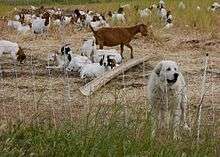
The dogs are introduced to livestock as puppies so they "imprint" on the animals. Experts recommend that the pups begin living with the herd at 4 to 5 weeks of age.[1] This imprinting is thought to be largely olfactory and occurs between 3 and 16 weeks of age. Training requires regular daily handling and management, preferably from birth. A guardian dog is not considered reliable until it is at least 2 years of age. Up until that time supervision, guidance and correction is needed to teach the dog the skill and rules it needs to do its job. Having older dogs that assist in training younger dogs streamlines this process considerably.
There are trials underway to protect penguins with livestock guardian dogs.[8]
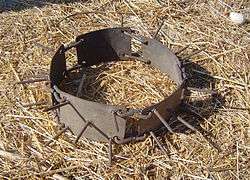
In Namibia in Southwest Africa, Anatolians are used to guard goat herds from cheetahs, and are typically imprinted between seven and eight weeks of age. Before use of dogs was implemented, impoverished Namibian farmers often came into conflict with predatory cheetahs; now, Anatolians usually are able to drive off cheetahs with their barking and displays of aggression.[9]
Traits
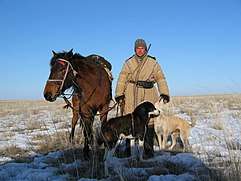
The three qualities most sought after in LGDs are trustworthiness, attentiveness and protectiveness—trustworthy in that they do not roam off and are not aggressive with the livestock, attentive in that they are situationally aware of threats by predators, and protective in that they will attempt to drive off predators. Dogs, being social creatures with differing personalities, will take on different roles with the herd and among themselves: most sticking close to the livestock, others tending to follow the shepherd or rancher when one is present, and some drifting farther from the livestock. These differing roles are often complementary in terms of protecting livestock, and experienced ranchers and shepherds sometimes encourage these differences by adjustments in socialization technique so as to increase the effectiveness of their group of dogs in meeting specific predator threats. LGDs that follow the livestock closest assure that a guard dog is on hand if a predator attacks, while LGDs that patrol at the edges of a flock or herd are in a position to keep would-be attackers at a safe distance from livestock. Those dogs that are more attentive tend to alert those that are more passive but perhaps also more trustworthy or less aggressive with the livestock.
At least two dogs may be placed with a flock or herd, depending on its size, the type of predators, their number, and the intensity of predation. If predators are scarce, one dog may be adequate, though most operations usually require at least two dogs. Large operations (particularly range operations) and heavy predator loads will require more dogs. Both male and female LGDs have proved to be equally effective in protecting of livestock.
While LGDs have been known to fight to the death with predators, in most cases predator attacks are prevented by a display of aggressiveness. LGDs are known to drive off predators that physically they would be no match for, such as bears and even lions. With the reintroduction of predators into natural habitats in Europe and North America, environmentalists have come to appreciate LGDs because they allow sheep and cattle farming to coexist with predators in the same or nearby habitats. Unlike trapping and poisoning, LGDs seldom kill predators; instead, their aggressive behaviors tend to condition predators to seek unguarded (thus, non-farm animal) prey. For instance, in Italy's Gran Sasso National Park, where LGDs and wolves have coexisted for centuries, older, more experienced wolves seem to "know" the LGDs and leave their flocks alone.
As pets
LGDs are generally large, independent and protective, which can make them less than ideal for urban or even suburban living. Nonetheless, despite their size, they can be gentle, make good companion dogs, and are often protective towards children. If introduced to a family as a pup, most LGDs are as protective of their family as a working guard dog is of its flock. In fact, in some communities where LGDs are a tradition, the runt of a litter would often be kept or given as a household pet or simply kept as a village dog without a single owner.
List of breeds
There are many breeds of LGDs, many of which are little known outside of the regions in which they are still worked. Nevertheless, some breeds are known to display traits advantageous to guarding livestock. Some specialist livestock guarding dog breeds include:
Extant breeds
| Breed | Alternate name(s) | Country of origin | Image |
|---|---|---|---|
| Aidi[10] | Aïdi, Atlas Mountain Dog, Atlas Shepherd Dog, Berber Dog, Chien de l'Atlas & Chien de Montagne de l'Atlas | Morocco | 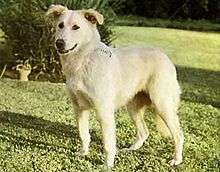 |
| Akbash dog[11] | Akbaş Çoban Köpeği | Turkey | 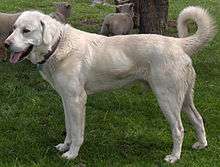 |
| Aksaray Malaklisi | Turkish mastiff & Central Anatolian shepherd | Turkey | 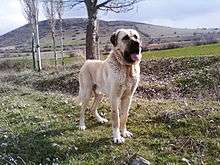 |
| Anatolian Shepherd[11] | Karabaş, Anadolulu Karabaş & Kangal | Turkey |  |
| Armenian Gampr | Gampr | Armenia | L |
| Ashayeri Dog | – | Iran | – |
| Azerbaijani Shepherd Dog | – | Azerbaijan | – |
| Bakharwal dog | – | India | – |
| Bucovina Shepherd | Bucovina Sheepdog & Southeastern European Shepherd | Romania & Serbia |  |
| Buryat-Mongolian Wolfhound | – | Russia | – |
| Cane di Mannara | Cane da pastore siciliano, Mastino siciliano | Italy (Sicily) |  |
| Cão de Castro Laboreiro | Dog of Castro Laboreiro, Portuguese Cattle Dog & Portuguese Watchdog | Portugal | 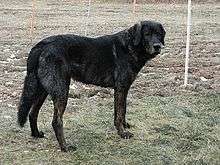 |
| Cão de Gado Transmontano | Transmontano Mastiff & Transmontano Cattle Dog | Portugal | |
| Carpathian Shepherd Dog | Ciobănesc Românesc Carpatin, Romanian Shepherd, Romanian Carpathian Shepherd, Câine Ciobănesc Carpatin, Carpathian Sheepdog, Carpatin & Romanian Carpatin Herder | Romania | 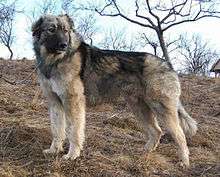 |
| Caucasian Shepherd Dog[12] | Caucasian Mountain Dog & Nagazi | Georgia, Armenia, Azerbaijan, | 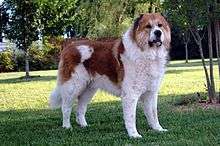 |
| Central Asian Shepherd Dog[13] | Alabai, Central Asian Ovtcharka & Aziat | Afghanistan, Kazakhstan, Kyrgyzstan, Turkmenistan, Uzbekistan & Russia | 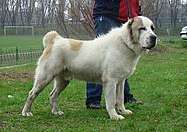 |
| Estrela Mountain Dog[14] | Portuguese Shepherd & Cão da Serra da Estrela | Portugal | 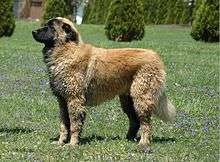 |
| Georgian Shepherd | Georgian Mountain Dog & Nagazi | Georgia | 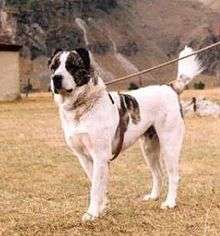 |
| Ghadrejani dog | – | Iran | – |
| Great Pyrenees[15] | Pyrenean Mountain Dog, Patou, Montañés del Pirineo, Perro de Montaña de los Pirineos, Can de Montaña de os Perinés, Chien des Pyrénées & Chien de Montagne des Pyrénées | France & Spain | 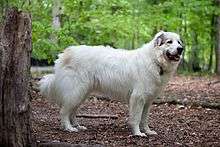 |
| Greek Shepherd | – | Greece | 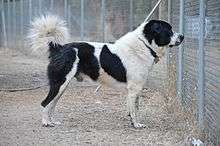 |
| Himalayan Sheepdog | Himalayan Shepherd & Himalayan Shepherd Dog | China, India & Nepal | 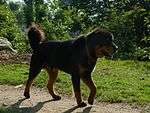 |
| Kangal | Sivas Kangal & Turkish Kangal | Turkey | 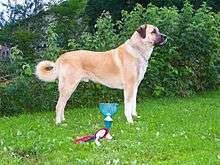 |
| Karakachan | Karakachansko Kuche & Karakachanska Ovcharka | Bulgaria |  |
| Karst Shepherd | – | Slovenia |  |
| Komondor[16] | Hungarian Komondor, Hungarian Sheepdog | Hungary | 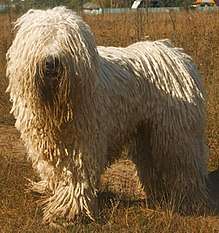 |
| Koyun dog | Bayburt Kelpi | Turkey | – |
| Kuchi | Sage Kuchi, Sage Jangi, De Kochyano Spai, Jangi Spai & Afghan Shepherd | Afghanistan | 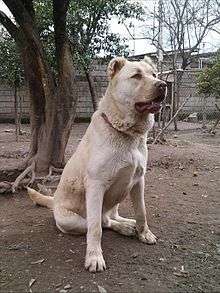 |
| Kurdish Shepherd Dog | – | Iran, Iraq & Kurdistan | – |
| Kuvasz[17] | Hungarian Kuvasz | Hungary | 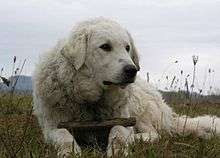 |
| Maremmano-Abruzzese Sheepdog[18] | Maremma Sheepdog, Cane da Pastore Maremmano-Abruzzese, Pastore Abruzzese, Pastore Maremmano, Abruzzo Sheepdog & Abruzzese Sheepdog | Italy |  |
| Mazandrani dog | – | Iran | |
| Mioritic Shepherd | Romanian Mioritic Shepherd Dog, Romanian Mioritic, Ciobănesc Românesc Mioritic, Mioritic | Romania | - |
| Mongolian banhar | – | Mongolia | – |
| Mucuchies[19] | – | Venezuela |  |
| Persian Mastiff | Sarabi Mastiff | Iran |  |
| Polish Tatra Sheepdog | Tatra Mountain Sheepdog, Owczarek Tatrzański, Owczarek Podhalański & Polski Owczarek | Poland | 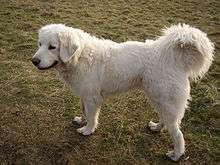 |
| Pyrenean Mastiff[20] | Mastín del Pirineo & Mostín d'o Pireneu | Spain | 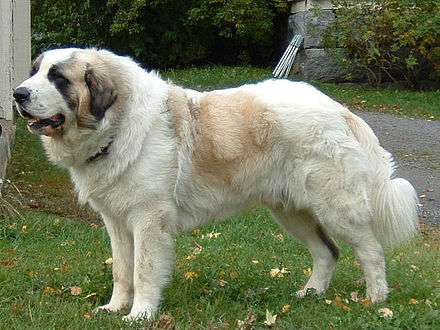 |
| Rafeiro do Alentejo | Alentejo Mastiff, Portuguese Mastiff & Mutt of Alentejo | Portugal | 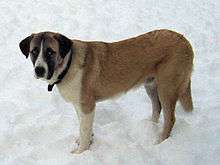 |
| Romanian Raven Shepherd Dog | Ciobanesc Romanesc Corb | Romania | – |
| Sardinian Shepherd Dog | Sardinian Shepherd Dog, Fonni's dog, Pastore fonnese, Cane fonnesu, Cani sardu antigu | Italy (Sardinia) | - |
| Šarplaninac | Yugoslavian Shepherd Dog | North Macedonia & Serbia (Kosovo) | 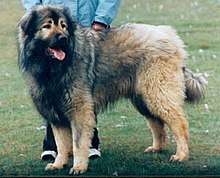 |
| Shirak Sheepdog | – | Iran | – |
| Slovak Cuvac[17] | Slovak Chuvach, Tatransky Cuvac & Slovak tschuvatsch | Slovakia | 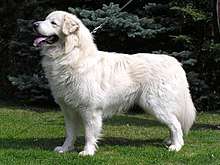 |
| Spanish Mastiff[21] | Mastín español de campo y trabajo, Mastín ganadero, Mastín Leonés & Mastín Extremeño | Spain | 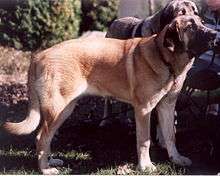 |
| Tibetan kyi apso[22] | Apso Do-Kyi | Tibet | – |
| Tibetan Mastiff[22] | – | Tibet | 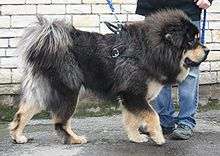 |
| Tobet | Kazakhstan mountain dog | Kazakhstan | – |
| Torkuz[23] | Sarkangik | Uzbekistan | – |
| Tornjak | Bosnian and Herzegovinian Shepherd Dog, Bosnian Shepherd Dog, Croatian Mountain Dog & Bosnian-Herzegovinian and Croatian Shepherd Dog | Bosnia and Herzegovina & Croatia |  |
| Vikhan Sheepdog | Chitral Watchdog & Pakistani Vikhan Dog | Pakistan | – |
List of extinct breeds
| Breed | Alternate name(s) | Country or region of origin | Era | Use | Image |
|---|---|---|---|---|---|
| Alpine Mastiff | — | Alps | Before 5th century BC to 19th century AD | Livestock guardian | 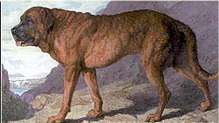 |
| Molossus | — | Southern Europe | Classical antiquity | War dogs, hunting, guard dogs & dog fighting |
See also
References
Citations
- Suzanne Asha Stone (2016). Livestock and Wolves: A Guide to Nonlethal Tools and Methods to Reduce Conflicts, 2nd Edition (PDF) (Report). Washington, DC: Defenders of Wildlife. Retrieved 2016-02-27.
- Barnes, Elizabeth (1998), "Working like a dog", Mother Earth News (168): 30
- Green, Jeffrey S.; Woodruff, Roger A. (1993). Livestock Guarding Dogs: Protecting Sheep From Predators (Rev. Oct. 1993 ed.). U.S. Dept. of Agriculture, Animal and Plant Health Inspection Service. p. 26. hdl:2027/umn.31951d012181083.
- Hansen, Inger; Staaland, Theresia; Ringsø, Aud (2002). "Patrolling with Livestock Guard Dogs: A Potential Method to Reduce Predation on Sheep". Acta Agriculturae Scandinavica, Section A. 52 (1): 43–48. doi:10.1080/09064700252806416.
- Gehring, Thomas M.; VerCauteren, Kurt C.; Landry, Jean-Marc (2010). "Livestock Protection Dogs in the 21st Century: Is an Ancient Tool Relevant to Modern Conservation Challenges?". BioScience. 60 (4): 299–308. doi:10.1525/bio.2010.60.4.8. Retrieved 2018-04-29.
- Virgil, The Georgics, Book III line 404-413
- Aristotle, History of Animals
- Warrnambool City Council - Penguin numbers up after world-first maremma trial
- About the cheetah
- Fogle (2009), p. 353.
- Fogle (2009), p. 351.
- Fogle (2009), p. 350.
- Fogle (2009), p. 349.
- Fogle (2009), p. 324.
- Fogle (2009), p. 347.
- Fogle (2009), p. 316.
- Fogle (2009), p. 317.
- Fogle (2009), p. 332.
- Morris (2001), p. 707.
- Fogle (2009), p. 387.
- Fogle (2009), p. 335.
- Fogle (2009), p. 343.
- Hancock (2014), p. 32.
Bibliography
- Fogle, Bruce (2009). The Encyclopedia of the Dog. New York: DK Publishing. ISBN 978-0-7566-6004-8.CS1 maint: ref=harv (link)
- Hancock, David (2014). Dogs of the shepherds: a review of the pastoral breeds. Ramsbury, Wiltshire: The Crowood Press Ltd. ISBN 978-1-84797-808-0.CS1 maint: ref=harv (link)
- Morris, Desmond (2001). Dogs:the ultimate guide to over 1,000 dog breeds. North Pomfret, VT: Trafalgar Square Publishing. ISBN 1-57076-219-8.CS1 maint: ref=harv (link)
Further reading
- Dohner, Janet Vorwald (December 12, 2007). Livestock Guardians: Using Dogs, Donkeys, and Llamas to Protect Your Herd. North Adams, MA: Storey Books. pp. 122–123. ISBN 9781580176958. Retrieved February 25, 2017.
- Dohner, Janet Vorwald (October 4, 2016). Farm Dogs: A Comprehensive Breed Guide to 93 Guardians, Herders, Terriers and other canine working partners. North Adams, MA: Storey Books. p. 117. ISBN 9781612125923. Retrieved February 25, 2017.
- Kojima, Toyoharu (August 28, 2005). Legacy of the Dog: The Ultimate Illustrated Guide (Revised and Updated, 2nd ed.). Chronicle Books LLC. ISBN 9780811851138.
External links
| Wikimedia Commons has media related to Livestock guardian dogs. |
- Livestock Guardian Dog Association
- Livestock and Wolves: A Guide to Nonlethal Tools and Methods to Reduce Conflicts, 2nd Edition
- Guarding Dogs: from the Transhumance to Pre-Zygotic Selection by Raymond Coppinger and Lorna Coppinger
- Livestock guarding dogs: their current use world wide by Robin Rigg, a comprehensive review of current livestock guarding dog use
- Livestock Guarding Dogs: Protecting Sheep from Predators, a USDA publication
- Attention, Sheep Grazing in this Area: Livestock Protection Dogs in Use, a USDA warning sign
- in-depth video about LGD use by shepherds from OPB
- Guardian Dogs: Best Practice Manual for the use of Livestock Guardian Dogs from Invasive Animals Cooperative Research Centre of Australia
- Livestock Guardian Dogs at Work: Another Side of The Great Pyrenees Mountain Dog